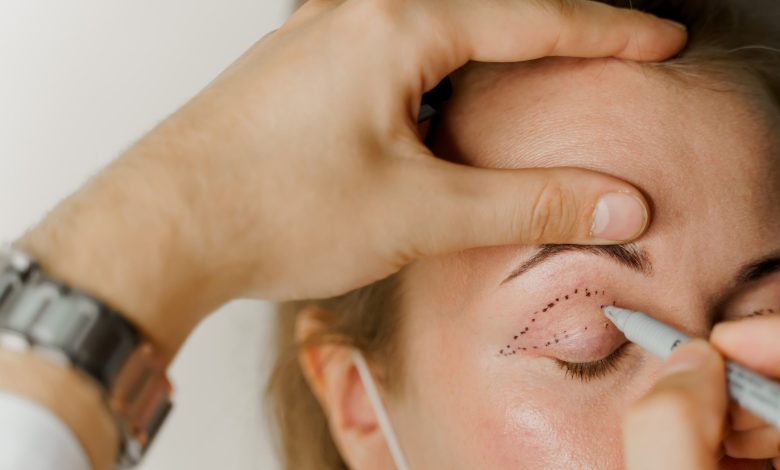What do I need to know about Eyelid Surgery?

Even though it’s a quick and basic procedure, many people understandably feel anxious about having surgery close to their eyes. Experts who specialise in all facets of cosmetic and reconstruction eye surgery are in the ideal position to explain everything that you need to understand about having a blepharoplasty. Experts describe the procedure’s potential benefits for you, what it entails, and what to anticipate during the healing process. The price range for double-eyelid surgery is somewhere between £2,000 and £6,000.
Why Do Some Individuals Require or Desire Eyelid Surgery?
Our eyelids and the skin around them might sag or droop over time. The same tired-looking, droopy eyelids might result from pockets of extra fat that some individuals have around their eyes. Long-term allergies, infections that stretch the skin, smoking, and prolonged sun exposure can all contribute to extra skin around the eyes. Sometimes, the weight of the extra skin can make it challenging to open your eyes, which can impair your eyesight. In other instances, some people just dislike the way their sagging eyelids look. In either case, blepharoplasty, a procedure to remove extra skin or fat from the eyelids, may be beneficial for medical, aesthetic, or both reasons.
What Kind Of Anaesthesia Is Used When Operating On The Eyelids?
A local anaesthetic and sedative can be used during a blepharoplasty. As a result, even though you’ll be awake, your eyelids will be numb.
You’ll feel at Ease and Sleepy
Another option is to have a general anaesthetic, which will put you to sleep throughout the treatment. At your pre-operative evaluation, you can talk to your surgeon about your alternatives, your preferences, and his or her preferences. You’ll often be able to leave the hospital on the day of your operation and go home.
What Is Done During Eyelid Surgery?
A blepharoplasty entails your surgeon removing any extra tissue that is contributing to the appearance of your eyelids being heavy, weary, or drooping, depending on whether you are having higher eyelid surgery, lower eyelid surgery, or both.
Upper Eyelid Surgery – What Is It?
To dramatically enhance the tone and smoothness of the epidermis between both the forehead and the upper eyelashes, an upper blepharoplasty is performed on the upper eyelids. It will aid in reducing the amount of extra skin that could make the top lids look heavy and wrinkled. To minimise wrinkling, your surgeon will create an incision in the upper eyelid area where the skin has its natural creases. They will next trim away any extra tissue (such as fat, muscle, or skin) that is the cause of the heavy eyelids before using tiny stitches to close the wound. In the weeks following surgery, these stitches are intend to disintegrate or fall out. Surgery on the upper eyelids often lasts an hour or less.
What Is Surgery On The Lower Lids?
To treat loose, sagging skin and eye bags between both the lower eyelashes and indeed the tops of the cheeks, a lower blepharoplasty is performed on the lower eyelids. Additionally, it can aid in reducing puffiness beneath the eyes and darker. Your surgeon will create incisions either just within the lower lash line or just below the upper lash line during lower lid surgery. The loose, fine lines and wrinkled skin and subcutaneous fat that are making the lower eyelashes droop and seem heavy will then be removed. The incision may then be close using suture strips or solvent sutures. Your transplant team will remove any suture strips if you had them about a week after the procedure. Surgery on the lower eyelid can take as much as two hours and is typically more time-consuming than surgery on the upper eyelid.
How Long Does It Take To Recuperate From Eyelid Surgery?
Following surgery, you may be given painkillers to take as the anaesthetic wears off. You could also have eye pads on for a short amount of time to lessen bruising. Your eye area will feel sensitive, swollen, and bruised in the days following surgery, dependent on whether you underwent upper eyelid surgery, lower eyelid surgery, or both. Dry eyes may also be an issue. In the months that follow the operation, you will receive comprehensive instructions on how to take care of your eyes.
To assist prevent infections from forming while your wounds heal, your surgeon can also prescribe you an antibiotic cream. It typically takes a week for the swelling and bruises to go down, but it could take approximately six months for the full effects of eyelid surgery to show. Following eyelid surgery, you will typically require about a week off from work and other regular activities. Additionally, you should avoid driving for a few months or for however long your surgeon advises.
Final Words
A common cosmetic surgical technique that can help improve the impression of drooping or sagging eyelids is eyelid surgery, sometimes referred to as blepharoplasty. Additionally, it helps ease any discomfort brought on by extra skin surrounding the eyes.




